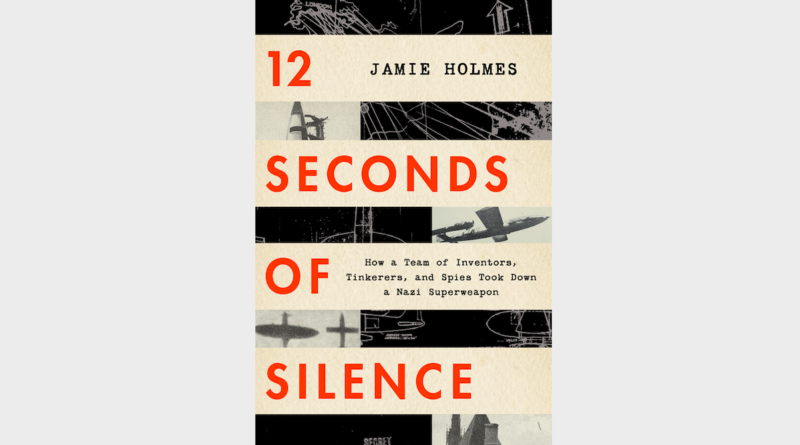REVIEW: ’12 Seconds of Silence’ by Jamie Holmes
Image courtesy of HMH / Provided by official site with permission.
Jamie Holmes’ new nonfiction book, 12 Seconds of Silence: How a Team of Inventors, Tinkerers, and Spies Took Down a Nazi Superweapon, is a remarkable fill-in-the-blanks history lesson about a pivotal time in the 20th century. Although the headlines from World War II are well known to modern audiences, throughout the years there have been books, movies and TV specials that have explored the unsung heroes and inventions that helped the Allies win the multi-year conflict. Holmes’ book fits nicely into this niche, telling the reader about the unprecedented dedication of scientist Merle Tuve and his Section T team members.
The book, running nearly 300 pages and another 100 pages of notes, details Tuve’s rising through the ranks in the years before the Americans formally joined the war effort. The backdrop to his ascendancy was the country’s refocusing on scientific intelligence, essentially giving “inventors, tinkerers, and spies” freedom to explore, experiment and do what they do best — all with the intent of developing ideas and inventions to stop the march of the Nazis across Europe and the Japanese army in the Pacific. After Pearl Harbor, their mission became even clearer.
Tuve and many of the men and women profiled in 12 Seconds of Silence answered this patriotic call, stopping their personal and professional lives, and dedicating their every minute to helping the United States, and by extension the United Kingdom and the world. Their advancements were not always welcomed with open arms; in fact, many of the military brass turned a skeptical eye to these newbies around the war table. However, over time, the “smart weapon” devised by these teams of scientists won over the military leadership, President Franklin Delano Roosevelt and Prime Minister Winston Churchill.
The story of how they developed and deployed this technology, which specifically helped antiaircraft efforts in England and in the Pacific, is a fascinating tale, made that much more engaging by Holmes’ exquisite writing and detailed descriptions. He knows the exact amount of personal anecdote to add to a professional story. He sets the scene, adds in a few extras to help the reader visualize what’s happening, and then it’s pages upon pages of invention-making, with plenty of tinkering and fine-tuning. At the beginning, Section T — so-called because of Tuve — had a seemingly insurmountable obstacle. How were they going to improve antiaircraft against the Nazis’ V-1, also known as the buzz bomb? How were they going to stop the Japanese air attacks on naval ships that were unable to strike back with enough accuracy? Put simply, the Allies needed the percentages of success in the air to increase, otherwise London would almost certainly fall to the advancing Axis Powers, and the Pacific Islands would be lost one by one.
Some of the most pivotal chapters of WWII serve as the heart of 12 Seconds of Silence, which pulls its name from the silence that occurred when a bomb’s engine stopped and the flying missile fell silently to the target below. The V-1’s unmerciful onslaught of London and its environs was dreadful and deadly, upending society in the European capital, and it’s clear from Holmes’ retelling that the work of Section T was sorely needed. The author slows down the narrative to talk about the lives lost during this unfortunate part of the war, and he also gives much ink to the spies who bravely ushered information and secrets from the German side to the Allies.
Much of the book is centered in the relative peacefulness of the mid-Atlantic where Section T was holed up in facilities that continued to grow as the war charged on. There were laboratories and testing fields, dorming for long nights and security guards to keep away possible spies. Tuve watched over the proceedings with a careful, stern eye, while his wife and two children stayed home and wondered where Daddy was. His sacrifice was immense, but of course it was a different sacrifice than the military personnel sent over to Europe and the Pacific. What Holmes does is give ample time to understanding the scientific arm of the military enterprise, showing a different kind of steely determination.
There are lessons to be learned in 2020, of course. A modern-day reader will take in these words and see how science informed politicians, public policy and military leaders, and yet that continues to be a big ask during a global pandemic. This was also a time of great national unity, which seems like a sepia-tinged image from yesteryear. It also details the beginnings and cementing of the Special Relationship between the U.K. and U.S., a time when a global effort was needed to stop a global evil.
12 Seconds of Silence is an important historical tale to learn from, and the book should be heralded for focusing on the dedication of these scientists who are finally receiving due credit.
By John Soltes / Publisher / John@HollywoodSoapbox.com
12 Seconds of Silence: How a Team of Inventors, Tinkerers, and Spies Took Down a Nazi Superweapon by Jamie Holmes. 416 pages. HMH. Click here for more information.

